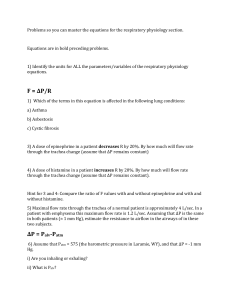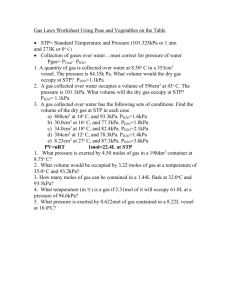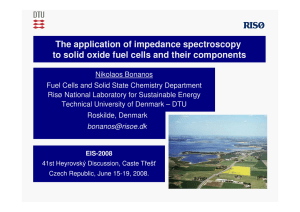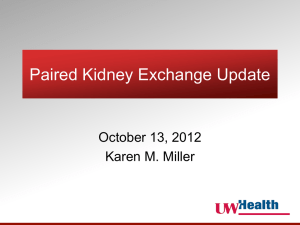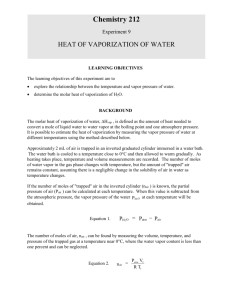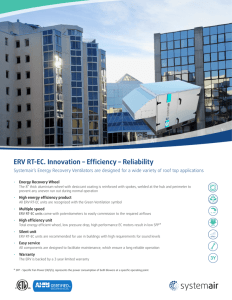Problems so you can master the equations for the respiratory
advertisement
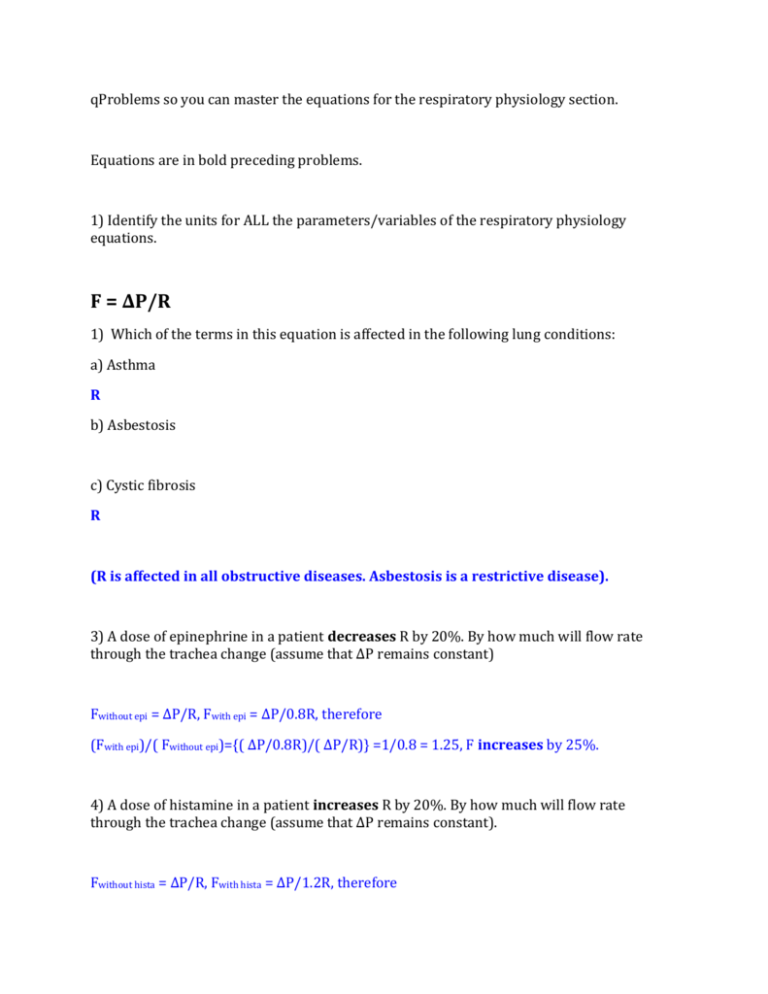
qProblems so you can master the equations for the respiratory physiology section.
Equations are in bold preceding problems.
1) Identify the units for ALL the parameters/variables of the respiratory physiology
equations.
F = ∆P/R
1) Which of the terms in this equation is affected in the following lung conditions:
a) Asthma
R
b) Asbestosis
c) Cystic fibrosis
R
(R is affected in all obstructive diseases. Asbestosis is a restrictive disease).
3) A dose of epinephrine in a patient decreases R by 20%. By how much will flow rate
through the trachea change (assume that ∆P remains constant)
Fwithout epi = ∆P/R, Fwith epi = ∆P/0.8R, therefore
(Fwith epi)/( Fwithout epi)={( ∆P/0.8R)/( ∆P/R)} =1/0.8 = 1.25, F increases by 25%.
4) A dose of histamine in a patient increases R by 20%. By how much will flow rate
through the trachea change (assume that ∆P remains constant).
Fwithout hista = ∆P/R, Fwith hista = ∆P/1.2R, therefore
(Fwith hista)/( Fwithout hista)={( ∆P/1.2R)/( ∆P/R)} =1/1.2 = 0.83, F decreases by ≈ 17%
Hint for 3 and 4: Compare the ratio of F values with and without epinephrine and with and
without histamine.
5) Maximal flow rate through the trachea of a normal patient is approximately 4 L/sec. In a
patient with emphysema this maximum flow rate is 1.2 L/sec. Assuming that ∆P is the same
in both patients (≈ 1 mm Hg), estimate the resistance to airflow in the airways of in these
two subjects.
If F =∆P/R, then R = ∆P/F
Thus in the normal patient R = (1 mm Hg)/(4 L/sec) = 0.25 (mm Hg x sec)/L,
and in the patient with emphysema
R = (1 mm Hg)/(1.2 L/sec) = 0.83 (mm Hg x sec)/L
R is 3.3 times higher in the patient with emphysema.
∆P = Palv-Patm
6) Assume that Patm = 575 (the barometric pressure in Laramie, WY), and that ∆P = -1 mm
Hg.
i) Are you inhaling or exhaling?
Inhaling, ∆P is sub-atmospheric.
ii) What is Palv?
Palv=Patm+∆P = 575 -1 = 574 mm Hg
6) What is the value of Pip (intrapleural pressure) in a pneumothorax?
Patm or higher in the case of a tension pneumothorax (in these, the wound forms a one way
valve that allows air in but not out and hence pressure builds up).
7) What is the value of ∆P in a pneumothorax?
0 or positive in the case of a tension pneumothorax (in these, the wound forms a one way
valve that allows air in but not out and hence pressure builds up).
Vital Capacity = Tidal Volume+Inspiratory Reserve Volume+Expiratory Reserve
Volume
8) Vital capacity in females of normal height equals ≈ 3.6 L, tidal volume is about 390 ml,
and inspiratory reserve volume is ≈ 2.3 L.
i) Estimate expiratory reserve volume.
VC = TV + IRV + ERV, Thus ERV = VC –(TV + IRV) = 3.6 – (0.39+2.3) = 0.91 L
ii) If residual volume equals 0.93 L what is the lung’s volume, which is also called total lung
capacity TLC (please refer to the spirometer’s figure in your slides).
TLC = IRV + TV + ERV + RV = VC +ERV = 3.6 + 0.91 = 4.5
(FEV1/FVC)x100
9) The following table has data for a normal subject and one with emphysema. Please
complete all entries in the table.
Normal
Emphysema
FEV1
4L
1.2 L
FVC
5L
3L
100x(FEV1/ FVC)
80%
40 %
Minute Volume = (Respiratory Rate)x(Tidal Volume)
Alveolar Ventilation = (Respiratory Rate)x(Tidal Volume-Dead Space Volume)
10) Morphine has strong effects on respiratory function. The following table shows data for
rabbits before and 1 h after they have been injected with 10 m/kg of morphine. Please
complete the table. Dead space volume was similar between treatments and equaled 7
ml/breath.
Before
After
Respiratory rate
(breaths/min)
42
17
Tidal volume (ml/breath)
24
31
Minute ventilation
1008
527
Alveolar ventilation
714
408
Ptot = ∑Px=PN2+PO2+…etc.
Px=(Fx/100)Patm
11) At sea level, atmospheric pressure equals 760 mm Hg. Estimate PN2 and PO2 assuming
temperatures of 10, 20 and 40° and assuming a) saturating PH2O and b) rh = 50%. To
answer this question you will have to refer to your notes.
PN2 = 0.78x(Patm –PH2O)
PO2 = 0.21x(Patm –PH2O)
All you need to do is estimate PH2O from the curve for the values at saturation. If rh = 50%
then the value of PH2O is 0.5 times the value that you read from the curve.
Henry’s Law: [x] = αxPx
12) Some hyperbaric chambers reach 2.8 times barometric pressure (i.e. 2128 mm Hg) and
use pure oxygen (i.e. FO2 = 100%).
a) Estimate the volume of dissolved oxygen in water in one of these chambers (O2 = 0.03
(ml O2/mm HgxL)).
0.03x2128 mm Hg = 63.84 ml/L
b) Estimate the volume of dissolved oxygen in blood (approximately) in a patient in one of
these chambers (at 37° C, PH2O ≈ 47 mm Hg).
0.03x(2128-47) = 62. 4 ml/L
Metabolic rate = Cardiac output ([O2]arteries –[O2]veins) or
VO2 = Q([O2]arteries –[O2]veins)
(recall that cardiac output = (stroke volume)x(heart rate) and that
cardiac output = (mean arterial pressure)/(total peripheral resistance))
13) Assume that metabolic rate equals 250 ml of O2/minute, that cardiac output equals 5 L
of blood per minute and that the concentration of oxygen in veins equals 150 ml/L.
Estimate the concentration of oxygen in arteries.
VO2 = Q([O2]arteries –[O2]veins)
Therefore
[O2] arteries = (VO2/Q) + [O2]veins = 250/5 + 150 = 200 ml/L
[O2]blood = [O2]solution + [O2]bound to hemoglobin
[O2] solution = αO2PO2
[O2]bound to hemoglobin = k[Hb]SO2(PO2)
(k = hemoglobin’s carrying (binding) capacity ≈ 1.4 ml O2/g, [Hb] = hemoglobin
concentration ≈ 150 g/L, SO2(PO2) = hemoglobin’s fractional saturation, 0 < SO2(PO2) < 1)
14) Refer to the hyperbaric chamber mentioned in question 12. What is the percentage of
oxygen in solution relative to the total oxygen content in arterial blood?
(62.4/(1.4X150 + 62.4))x100 = 22.9 %
15) What is the percentage of oxygen in solution relative to the total oxygen content in
arterial blood at sea level? Assume that PO2(alveolar) = 110 mm Hg
[O2] solution = 0.03x110 = 3.3 ml/L
[O2]bound to hemoglobin = 1.4x150x1 = 210 ml/L
Therefore 100x([O2] solution)/( [O2] solution + [O2]bound to hemoglobin) = 100x(3/213)=1.4 %.
